Broadband Vibration Attenuation Achieved by 2D Elasto-Acoustic Metamaterial Plates with Rainbow Stepped Resonators
Abstract
:1. Introduction
2. FE Modelling of Metamaterial Plates
3. Validation of the FE Models
4. Results and Discussion
4.1. Periodic Metamaterial Plate
4.2. Rainbow Metamaterial Plate
5. Conclusions
Author Contributions
Funding
Institutional Review Board Statement
Informed Consent Statement
Data Availability Statement
Conflicts of Interest
References
- Pendry, J.B. Negative Refraction Makes a Perfect Lens. Phys. Rev. Lett. 2000, 85, 3966–3969. [Google Scholar] [CrossRef] [PubMed]
- Pendry, J.B. Negative refraction. Contemp. Phys. 2004, 45, 191–202. [Google Scholar] [CrossRef] [Green Version]
- Shelby, R.A.; Smith, D.R.; Schultz, S. Experimental verification of a negative index of refraction. Science 2000, 292, 77–79. [Google Scholar] [CrossRef] [PubMed] [Green Version]
- Zhang, S.; Park, Y.-S.; Li, J.; Lu, X.; Zhang, W.; Zhang, X. Negative Refractive Index in Chiral Metamaterials. Phys. Rev. Lett. 2009, 102, 023901. [Google Scholar] [CrossRef] [Green Version]
- Iyer, A.K.; Eleftheriades, G.V. Negative refractive index metamaterials supporting 2-D waves. In Proceedings of the 2002 IEEE MTT-S International Microwave Symposium Digest (Cat. No. 02CH37278), Seattle, WA, USA, 2–7 June 2002; Volume II, pp. 1067–1070. [Google Scholar]
- Zhang, S.; Fan, W.; Panoiu, N.C.; Malloy, K.J.; Osgood, R.M.; Brueck, S.R.J. Experimental demonstration of near-infrared negative-index metamaterials. Phys. Rev. Lett. 2005, 95, 137404. [Google Scholar] [CrossRef] [Green Version]
- Schurig, D.R.S.D.; Mock, J.J.; Smith, D.R. Electric-field-coupled resonators for negative permittivity metamaterials. Appl. Phys. Lett. 2006, 88, 041109. [Google Scholar] [CrossRef] [Green Version]
- Engheta, N. An idea for thin subwavelength cavity resonators using metamaterials with negative permittivity and permeability. IEEE Antenn. Wirel. Pr. 2000, 1, 10–13. [Google Scholar] [CrossRef] [Green Version]
- Bilal, R.M.H.; Saeed, M.A.; Choudhury, P.K.; Baqir, M.A.; Kamal, W.; Ali, M.M.; Rahim, A.A. Elliptical metallic rings-shaped fractal metamaterial absorber in the visible regime. Sci. Rep. 2020, 10, 1–12. [Google Scholar]
- Yao, S.; Zhou, X.; Hu, G. Experimental study on negative effective mass in a 1D mass–spring system. New J. Phys. 2008, 10, 043020. [Google Scholar] [CrossRef]
- Gao, M.; Wu, Z.; Wen, Z. Effective Negative Mass Nonlinear Acoustic Metamaterial with Pure Cubic Oscillator. Adv. Civ. Eng. 2018, 2018, 1–15. [Google Scholar] [CrossRef] [Green Version]
- Cselyuszka, N.; Sečujski, M.; Crnojević-Bengin, V. Novel negative mass density resonant metamaterial unit cell. Phys. Lett. A 2015, 379, 33–36. [Google Scholar] [CrossRef]
- Huang, H.; Sun, C. Wave attenuation mechanism in an acoustic metamaterial with negative effective mass density. New J. Phys. 2009, 11, 013003. [Google Scholar] [CrossRef]
- Fang, N.; Xi, D.; Xu, J.; Ambati, M.; Srituravanich, W.; Sun, C.; Zhang, X. Ultrasonic metamaterials with negative modulus. Nat. Mat. 2006, 5, 452. [Google Scholar] [CrossRef] [PubMed]
- Ding, C.; Hao, L.; Zhao, X. Two-dimensional acoustic metamaterial with negative modulus. J. Appl. Phys. 2010, 108, 074911. [Google Scholar]
- Hao, L.M.; Ding, C.L.; Zhao, X.P. Tunable acoustic metamaterial with negative modulus. Appl. Phys. A. 2012, 106, 807–811. [Google Scholar] [CrossRef]
- Ding, Y.; Liu, Z.; Qiu, C.; Shi, J. Metamaterial with simultaneously negative bulk modulus and mass density. Phys. Rev. Lett. 2007, 99, 093904. [Google Scholar] [CrossRef] [PubMed]
- Liu, X.N.; Hu, G.K.; Huang, G.L.; Sun, C.T. An elastic metamaterial with simultaneously negative mass density and bulk modulus. Appl. Phys. Lett. 2011, 98, 251907. [Google Scholar] [CrossRef] [Green Version]
- Wu, Y.; Lai, Y.; Zhang, Z.Q. Elastic Metamaterials with Simultaneously Negative Effective Shear Modulus and Mass Density. Phys. Rev. Lett. 2011, 107, 105506. [Google Scholar] [CrossRef]
- Lee, S.H.; Wright, O.B. Origin of negative density and modulus in acoustic metamaterials. Phys. Rev. B. 2016, 93, 024302. [Google Scholar] [CrossRef] [Green Version]
- Liu, Z.; Zhang, X.; Mao, Y.; Zhu, Y.Y.; Yang, Z.; Chan, C.T.; Sheng, P. Locally resonant sonic materials. Science 2000, 289, 1734–1736. [Google Scholar] [CrossRef]
- Sugino, C.; Leadenham, S.; Ruzzene, M.; Erturk, A. On the mechanism of bandgap formation in locally resonant finite elastic metamaterials. J. Appl. Phys. 2016, 120, 134501. [Google Scholar] [CrossRef]
- Pai, P.F.; Peng, H.; Jiang, S. Acoustic metamaterial beams based on multi-frequency vibration absorbers. Int. J. Mech. Sci. 2014, 79, 195–205. [Google Scholar] [CrossRef]
- Huang, H.H.; Lin, C.K.; Tan, K.T. Attenuation of transverse waves by using a metamaterial beam with lateral local resonators. Smart Mater. Struct. 2016, 25, 085027. [Google Scholar] [CrossRef]
- Liu, Y.; Yu, D.; Li, L.; Zhao, H.; Wen, J.; Wen, X. Design guidelines for flexural wave attenuation of slender beams with local resonators. Phys. Lett. A. 2007, 362, 344–347. [Google Scholar] [CrossRef]
- Yu, D.; Liu, Y.; Zhao, H.; Wang, G.; Qiu, J. Flexural vibration band gaps in Euler-Bernoulli beams with locally resonant structures with two degrees of freedom. Phys. Rev. B. 2006, 73, 064301. [Google Scholar] [CrossRef]
- Xiao, Y.; Wen, J.; Wen, X. Longitudinal wave band gaps in metamaterial-based elastic rods containing multi-degree-of-freedom resonators. New J. Phys. 2012, 14, 033042. [Google Scholar] [CrossRef]
- Xiao, Y.; Wen, J.; Yu, D.; Wen, X. Flexural wave propagation in beams with periodically attached vibration absorbers: Band-gap behavior and band formation mechanisms. J. Sound. Vib. 2013, 332, 867–893. [Google Scholar] [CrossRef]
- Nobrega, E.D.; Gautier, F.; Pelat, A.; Dos Santos, J.M.C. Vibration band gaps for elastic metamaterial rods using wave finite element method. Mech. Syst. Signal Pr. 2016, 79, 192–202. [Google Scholar] [CrossRef]
- Peng, H.; Pai, P.F. Acoustic metamaterial plates for elastic wave absorption and structural vibration suppression. Int. J. Mech. Sci. 2014, 89, 350–361. [Google Scholar] [CrossRef]
- Peng, H.; Pai, P.F.; Deng, H. Acoustic multi-stopband metamaterial plates design for broadband elastic wave absorption and vibration suppression. Int. J. Mech. Sci. 2015, 103, 104–114. [Google Scholar] [CrossRef]
- Miranda, E.J.P., Jr.; Nobrega, E.D.; Ferreira, A.H.R.; Dos Santos, J.M.C. Flexural wave band gaps in a multi-resonator elastic metamaterial plate using Kirchhoff-Love theory. Mech. Syst. Signal Pr. 2019, 116, 480–504. [Google Scholar] [CrossRef]
- Wang, T.; Sheng, M.P.; Guo, Z.W.; Qin, Q.H. Acoustic characteristics of damped metamaterial plate with parallel attached resonators. Arch. Mech. 2017, 69, 29–52. [Google Scholar]
- He, Z.; Xiao, X.; Li, E. Design for structural vibration suppression in laminate acoustic metamaterials. Compos. Part B-Eng. 2017, 131, 237–252. [Google Scholar] [CrossRef] [Green Version]
- Hsu, J.C. Local resonances-induced low-frequency band gaps in two-dimensional phononic crystal slabs with periodic stepped resonators. J. Phys. D: Appl. Phys. 2011, 44, 055401. [Google Scholar] [CrossRef]
- Zhang, S.; Wu, J.H.; Hu, Z. Low-frequency locally resonant band-gaps in phononic crystal plates with periodic spiral resonators. J. Appl. Phys. 2013, 113, 163511. [Google Scholar] [CrossRef] [Green Version]
- Qin, Q.; Sheng, M.; Guo, Z. Low-Frequency Vibration and Radiation Performance of a Locally Resonant Plate Attached with Periodic Multiple Resonators. Appl. Sci. 2020, 10, 2843. [Google Scholar] [CrossRef] [Green Version]
- Nouh, M.; Aldraihem, O.; Baz, A. Wave propagation in metamaterial plates with periodic local resonances. J. Sound. Vib. 2015, 341, 53–73. [Google Scholar] [CrossRef]
- Li, Y.; Zhu, L.; Chen, T. Plate-type elastic metamaterials for low-frequency broadband elastic wave attenuation. Ultrasonics 2017, 73, 34–42. [Google Scholar] [CrossRef]
- Xiao, Y.; Wen, J.; Wen, X. Sound transmission loss of metamaterial-based thin plates with multiple subwavelength arrays of attached resonators. J. Sound Vib. 2012, 331, 5408–5423. [Google Scholar] [CrossRef]
- Sharma, G.S.; Sarkar, A. Directivity based control of acoustic radiation. Appl. Acoust. 2019, 154, 226–235. [Google Scholar] [CrossRef]
- Sharma, G.S.; Sarkar, A. Directivity-based passive barrier for local control of low-frequency noise. J. Theor. Comput. Acoust. 2018, 26, 1850012. [Google Scholar] [CrossRef]
- Elmadih, W.; Chronopoulos, D.; Syam, W.P.; Maskery, I.; Meng, H.; Leach, R.K. Three-dimensional resonating metamaterials for low-frequency vibration attenuation. Sci. Rep. 2019, 9, 1–8. [Google Scholar]
- Yuan, B.; Humphrey, V.F.; Wen, J.; Wen, X. On the coupling of resonance and Bragg scattering effects in three-dimensional locally resonant sonic materials. Ultrasonics 2013, 53, 1332–1343. [Google Scholar] [CrossRef]
- Krushynska, A.; Kouznetsova, V.; Geers, M. Visco-elastic effects on wave dispersion in three-phase acoustic metamaterials. J. Mech. Phys. Solids 2016, 96, 29–47. [Google Scholar] [CrossRef] [Green Version]
- Krushynska, A.O.; Miniaci, M.; Kouznetsova, V.G.; Geers, M.G. Multilayered inclusions in locally resonant metamaterials: Two-dimensional versus three-dimensional modeling. J. Vib. Acoust. 2017, 139, 024501. [Google Scholar] [CrossRef] [Green Version]
- Jiang, W.; Yin, M.; Liao, Q.; Xie, L.; Yin, G. Three-dimensional single-phase elastic metamaterial for low-frequency and broadband vibration mitigation. J. Mech. Sci. 2021, 190, 106023. [Google Scholar] [CrossRef]
- Mizukami, K.; Kawaguchi, T.; Ogi, K.; Koga, Y. Three-dimensional printing of locally resonant carbon-fiber composite metastructures for attenuation of broadband vibration. Compos. Struct. 2021, 255, 112949. [Google Scholar] [CrossRef]
- An, X.; Lai, C.; He, W.; Fan, H. Three-dimensional meta-truss lattice composite structures with vibration isolation performance. Extreme Mech. Lett. 2019, 33, 100577. [Google Scholar] [CrossRef]
- D’Alessandro, L.; Ardito, R.; Braghin, F.; Corigliano, A. Low frequency 3D ultra-wide vibration attenuation via elastic metamaterial. Sci. Rep. 2019, 9, 1–8. [Google Scholar] [CrossRef] [Green Version]
- Dal Poggetto, V.F.; Serpa, A.L. Elastic wave band gaps in a three-dimensional periodic metamaterial using the plane wave expansion method. Int. J. Mech. Sci. 2020, 184, 105841. [Google Scholar] [CrossRef]
- Zhu, J.; Chen, Y.; Zhu, X.; Garcia-Vidal, F.J.; Yin, X.; Zhang, W.; Zhang, X. Acoustic rainbow trapping. Sci. Rep. 2013, 3, 1–6. [Google Scholar] [CrossRef] [Green Version]
- Wang, B.; Huang, Y.; Zhou, W.; Yang, Z. Metamaterial beam for flexural wave resonance rainbow trapping and piezoelectric energy harvesting. J. Appl. Phys. 2021, 129, 064505. [Google Scholar] [CrossRef]
- Beli, D.; Fabro, A.T.; Ruzzene, M.; Arruda, J.R.F. Wave attenuation and trapping in 3D printed cantilever-in-mass metamaterials with spatially correlated variability. Sci. Rep. 2019, 9, 1–11. [Google Scholar] [CrossRef]
- Meng, H.; Bailey, N.; Chen, Y.; Wang, L.; Ciampa, F.; Fabro, A.; Chronopoulos, D.; Elmadih, W. 3D rainbow phononic crystals for extended vibration attenuation bands. Sci. Rep. 2020, 10, 18989. [Google Scholar] [CrossRef] [PubMed]
- Meng, H.; Chronopoulos, D.; Bailey, N.; Wang, L. Investigation of 2D Rainbow Metamaterials for Broadband Vibration Attenuation. Materials 2020, 13, 5225. [Google Scholar] [CrossRef] [PubMed]
- Meng, H.; Chronopoulos, D.; Fabro, A.T. Numerical simulation data for the dynamic properties of rainbow metamaterials. Data In Brief 2020, 28, 104772. [Google Scholar] [CrossRef]
- Meng, H.; Chronopoulos, D.; Fabro, A.T.; Elmadih, W.; Maskery, I. Rainbow metamaterials for broadband multi-frequency vibration attenuation: Numerical analysis and experimental validation. J. Sound Vib. 2020, 465, 115005. [Google Scholar] [CrossRef]
- Meng, H.; Chronopoulos, D.; Fabro, A.T.; Maskery, I.; Chen, Y. Optimal design of rainbow elastic metamaterials. Int. J. Mech. Sci. 2020, 165, 105185. [Google Scholar] [CrossRef]
- Xiao, Y.; Wen, J.; Wen, X. Flexural wave band gaps in locally resonant thin plates with periodically attached spring–mass resonators. J. Phys. D: Appl. Phys. 2012, 45, 195401. [Google Scholar] [CrossRef]
- Xie, L.; Xia, B.; Liu, J.; Huang, G.; Lei, J. An improved fast plane wave expansion method for topology optimization of phononic crystals. Int. J. Mech. Sci. 2017, 120, 171–181. [Google Scholar] [CrossRef]
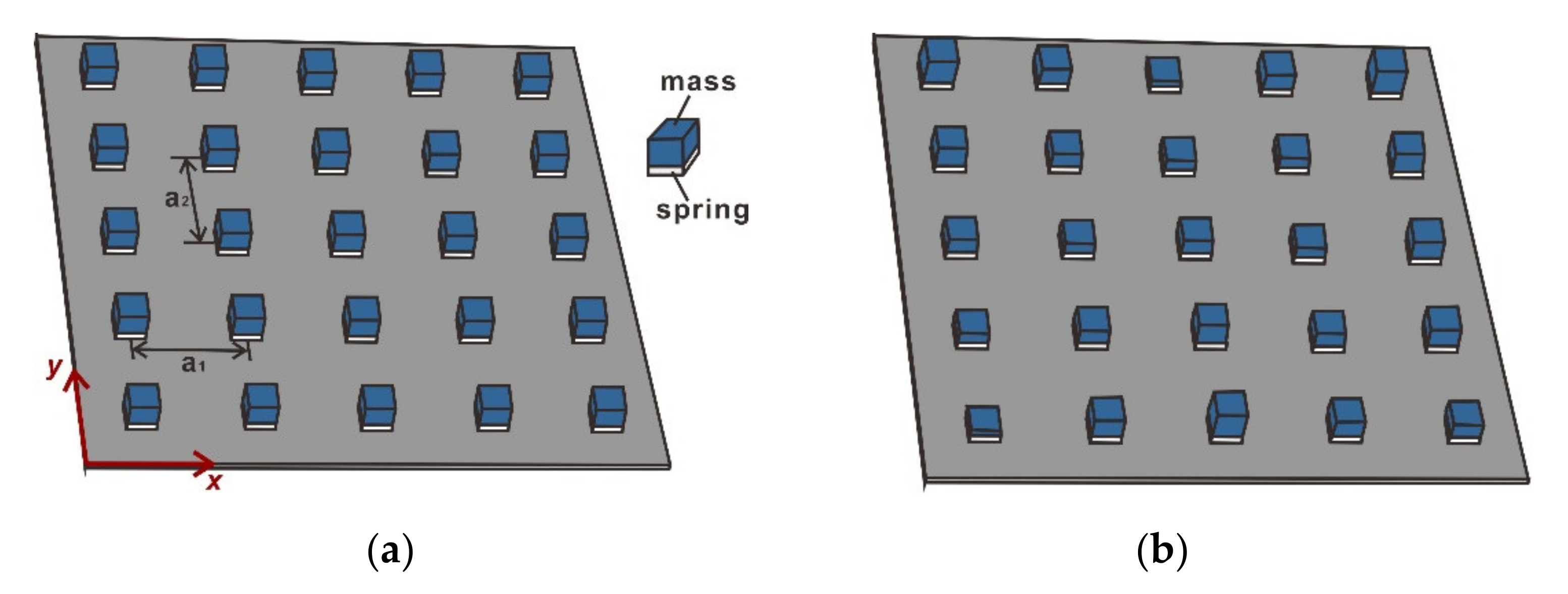
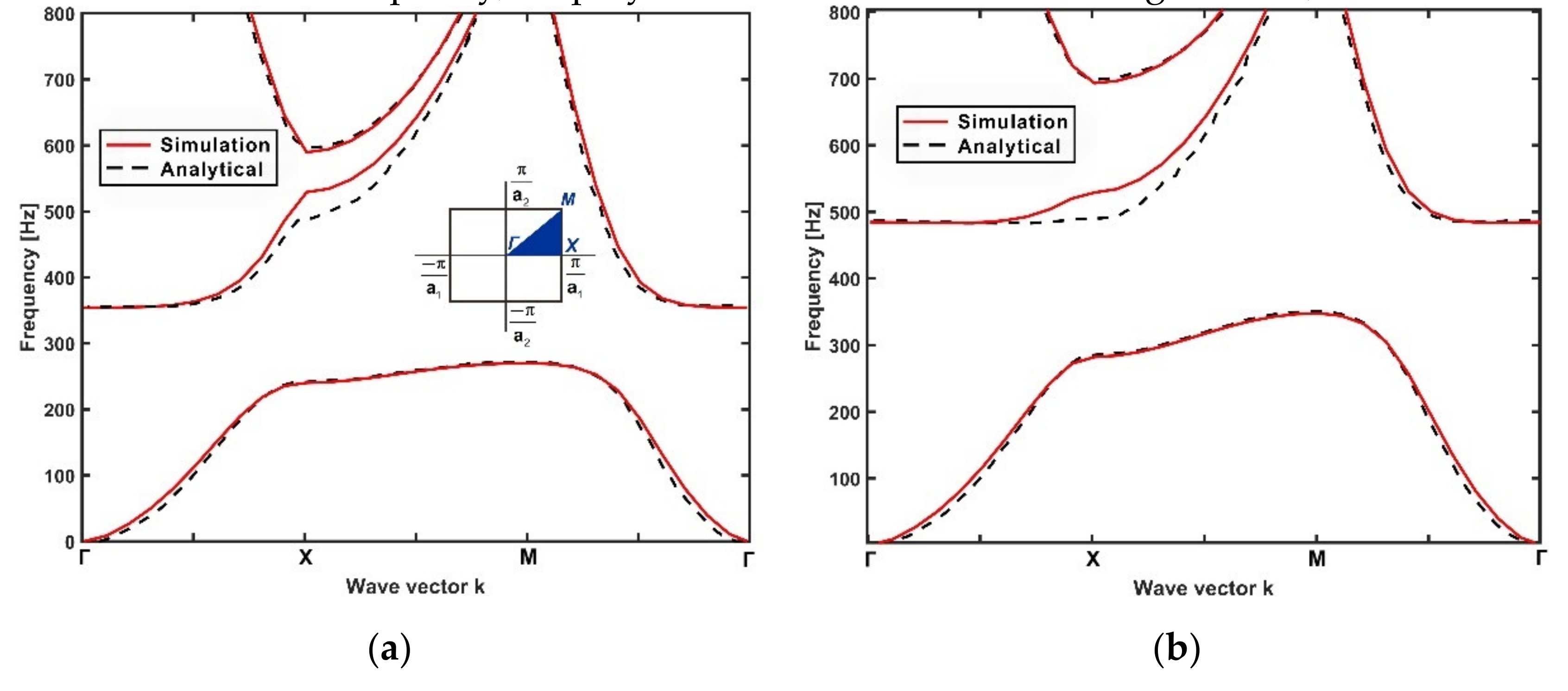

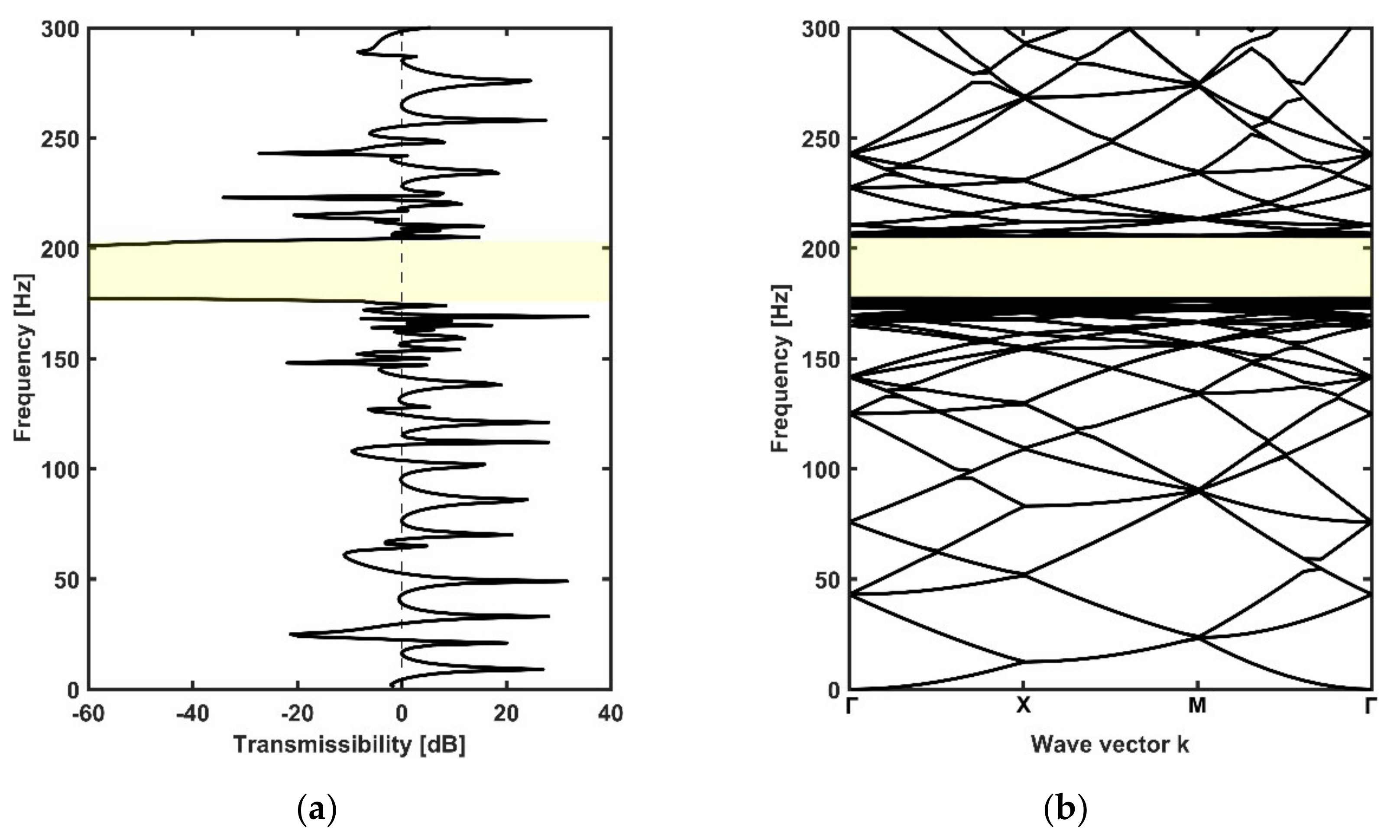
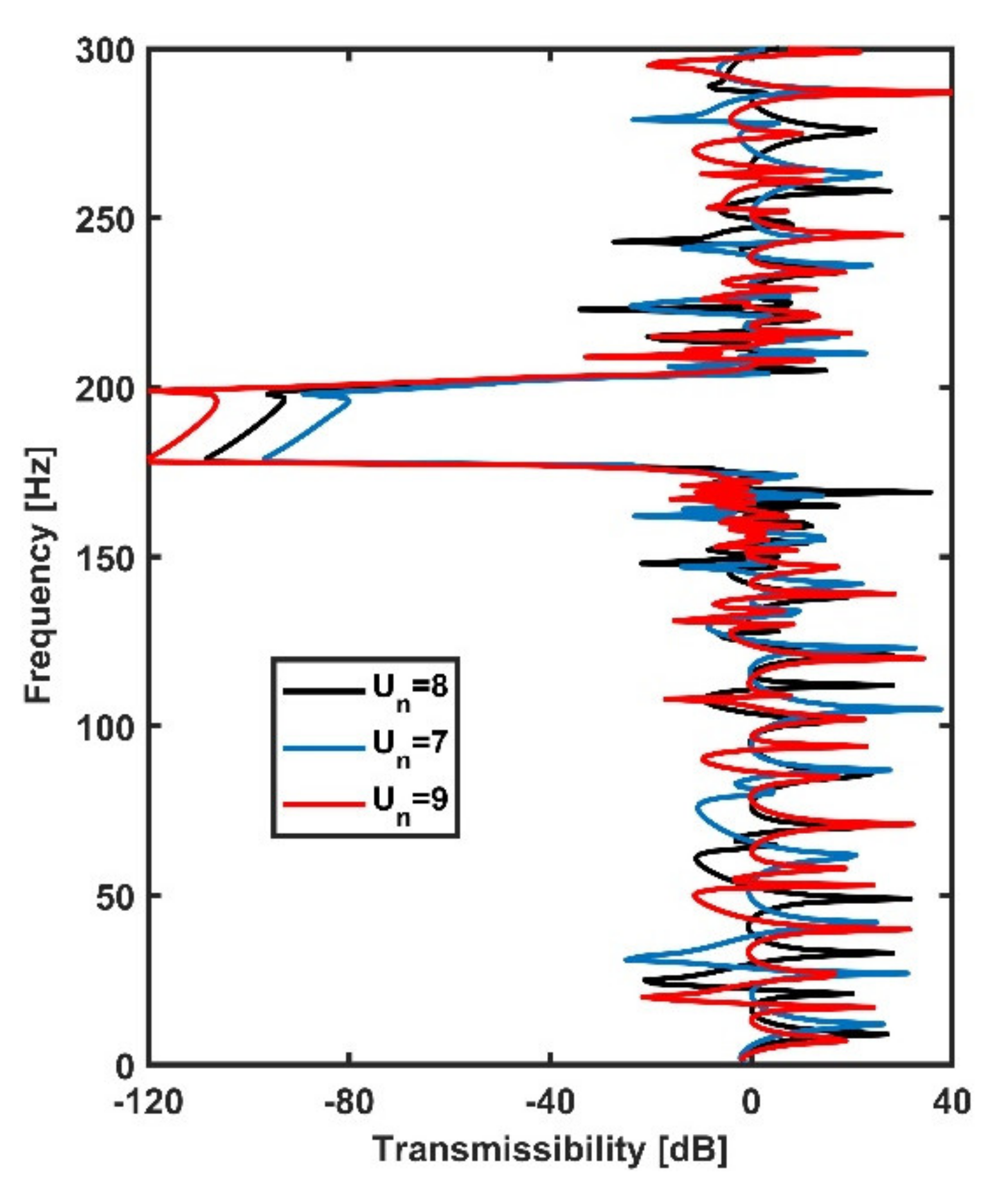
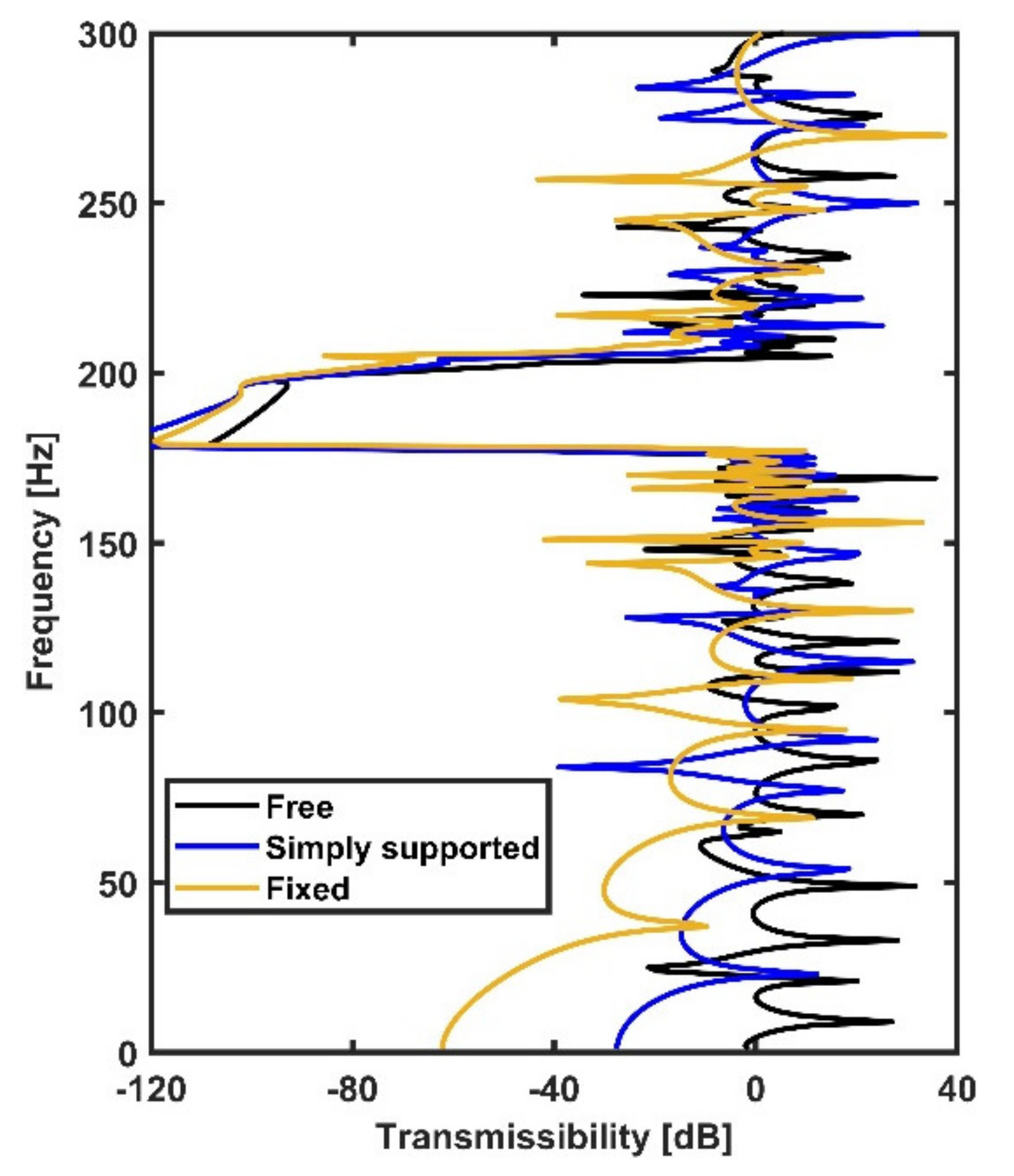
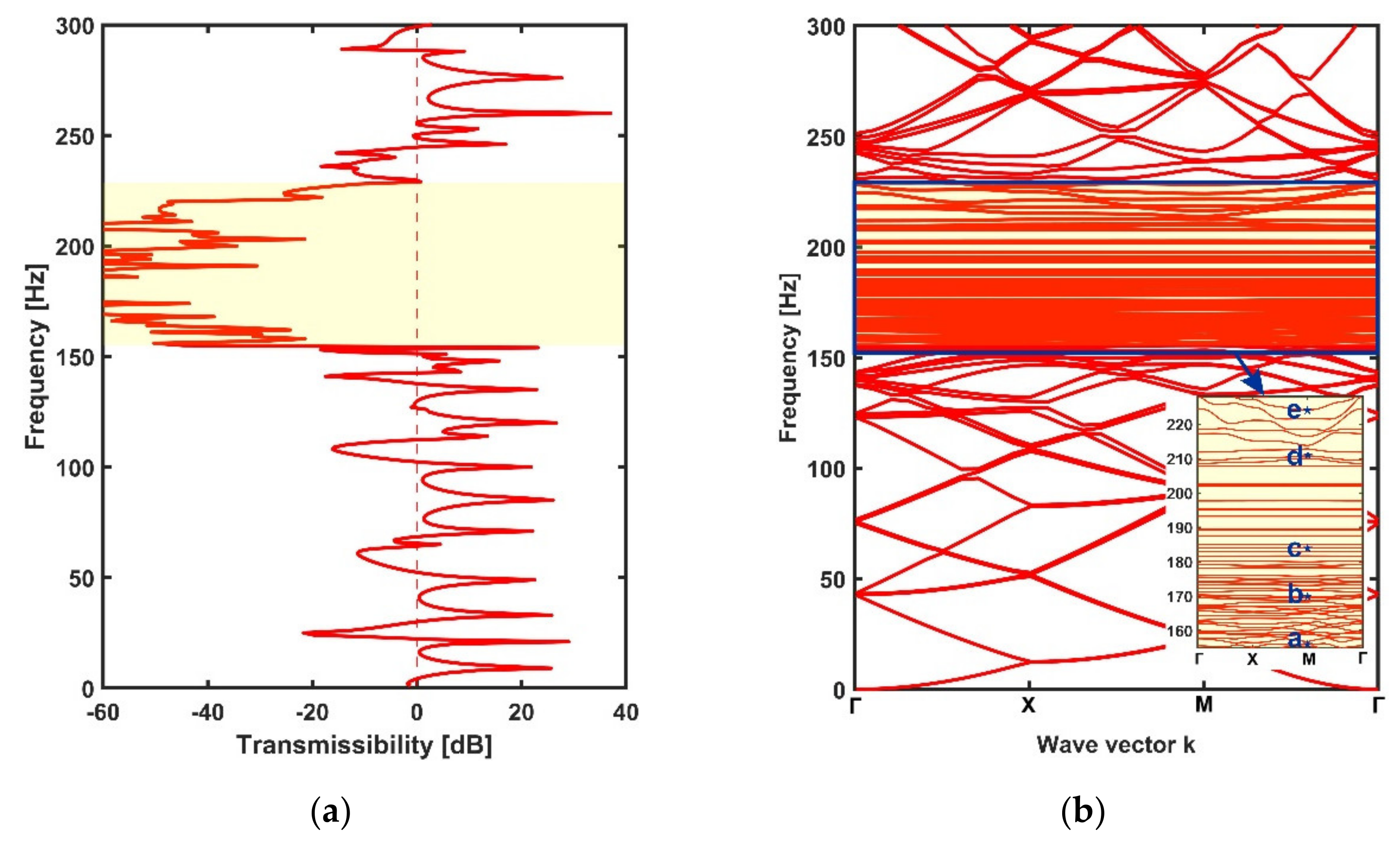
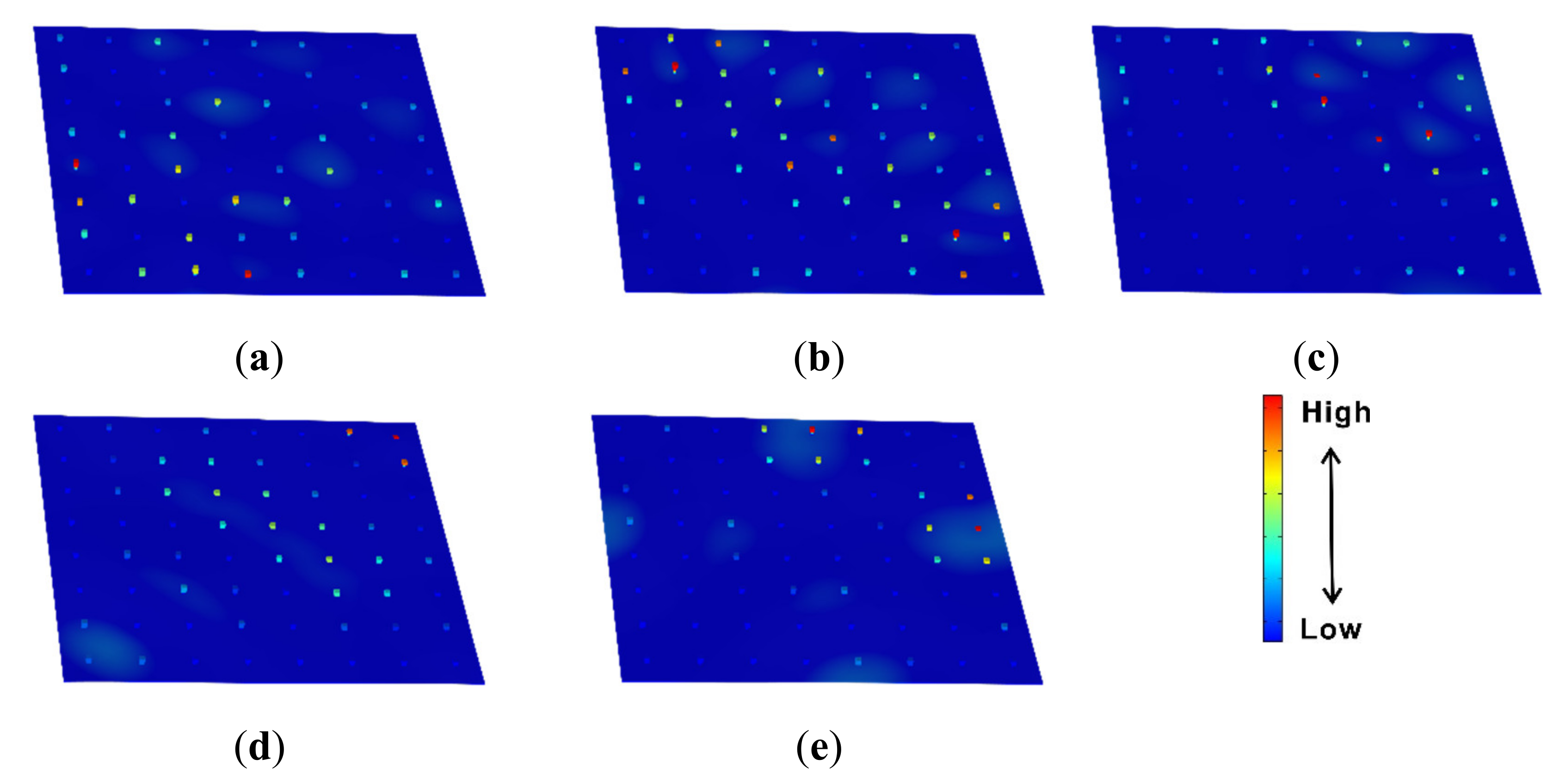
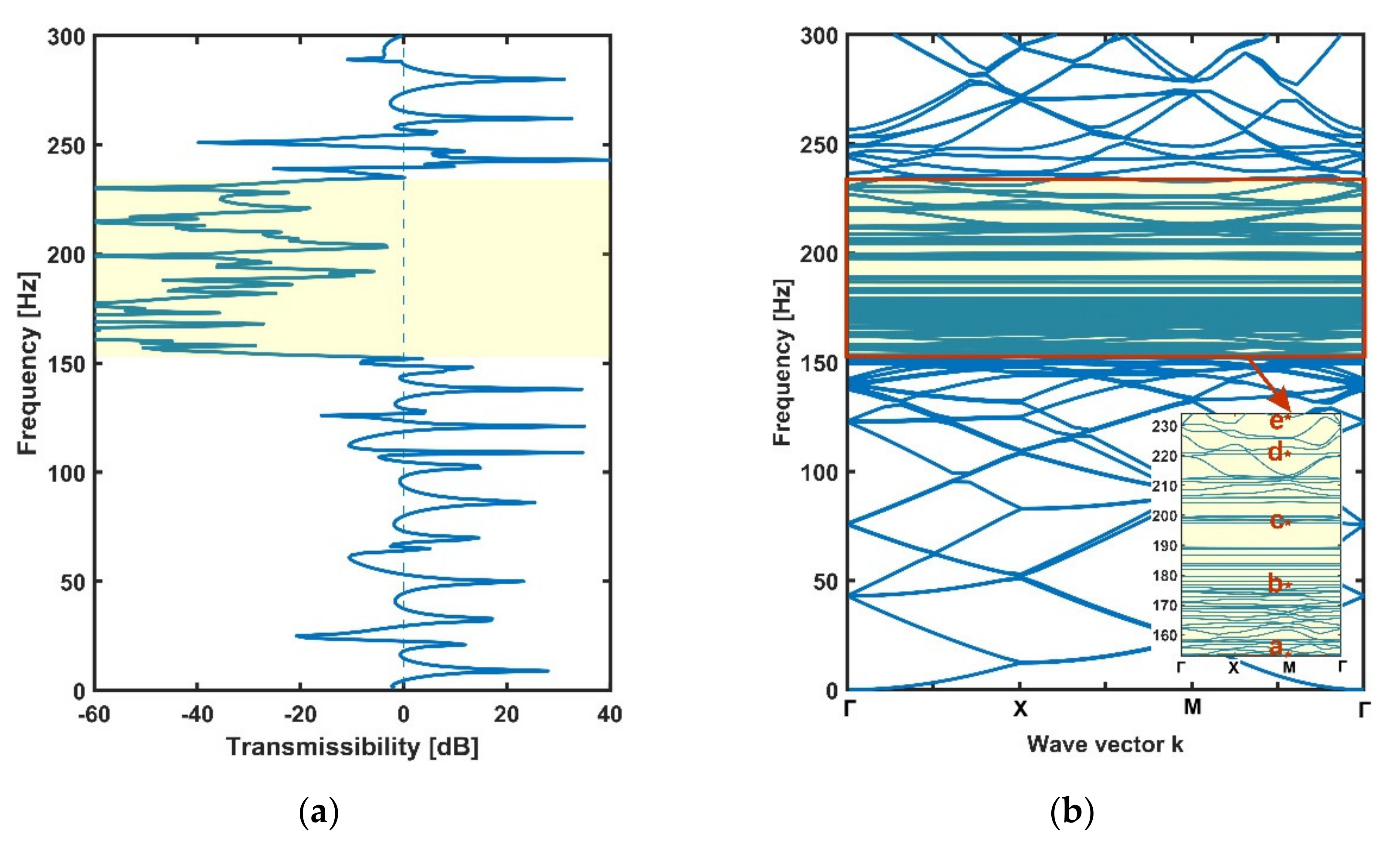
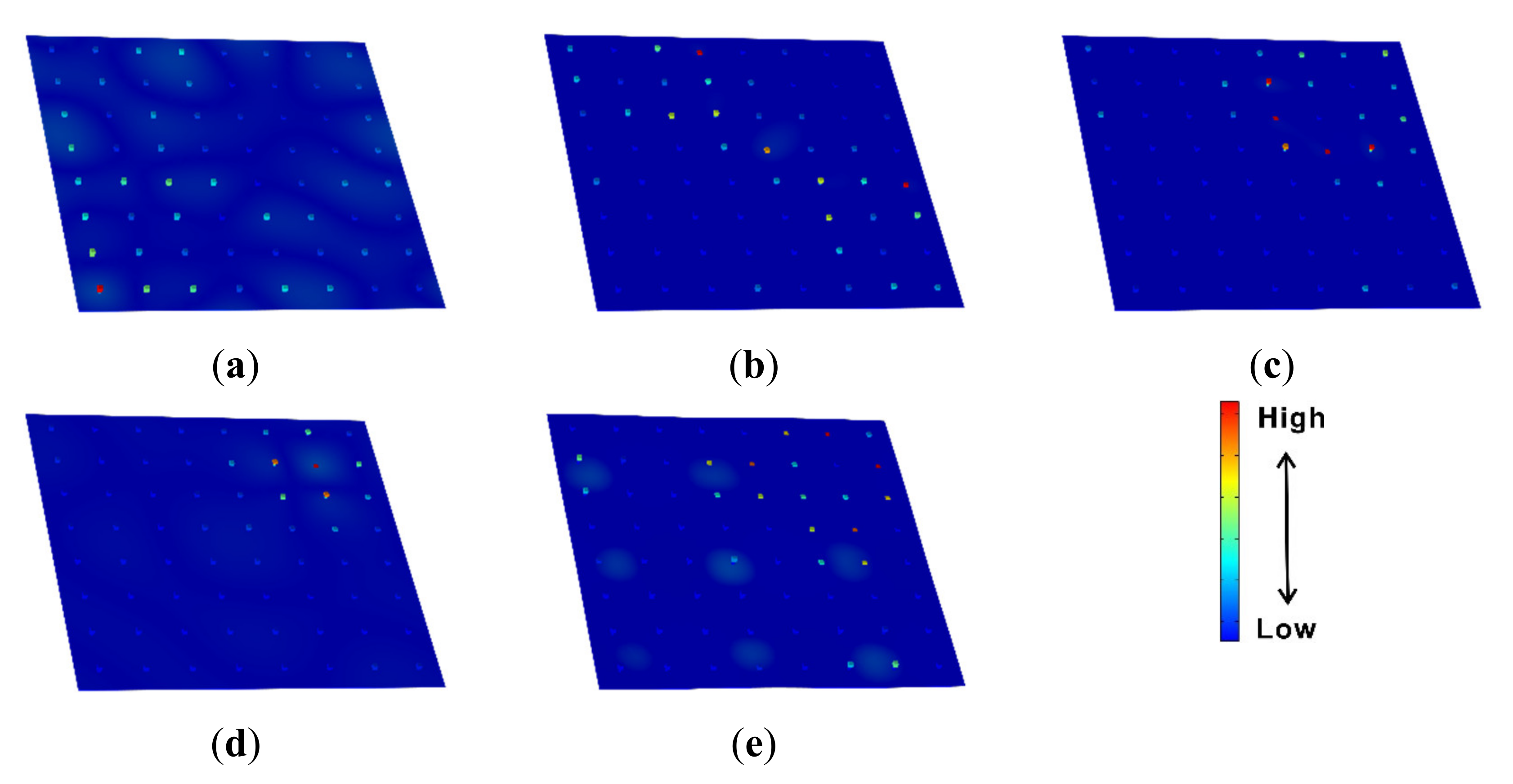
Publisher’s Note: MDPI stays neutral with regard to jurisdictional claims in published maps and institutional affiliations. |
© 2021 by the authors. Licensee MDPI, Basel, Switzerland. This article is an open access article distributed under the terms and conditions of the Creative Commons Attribution (CC BY) license (https://creativecommons.org/licenses/by/4.0/).
Share and Cite
Wei, W.; Chronopoulos, D.; Meng, H. Broadband Vibration Attenuation Achieved by 2D Elasto-Acoustic Metamaterial Plates with Rainbow Stepped Resonators. Materials 2021, 14, 4759. https://doi.org/10.3390/ma14174759
Wei W, Chronopoulos D, Meng H. Broadband Vibration Attenuation Achieved by 2D Elasto-Acoustic Metamaterial Plates with Rainbow Stepped Resonators. Materials. 2021; 14(17):4759. https://doi.org/10.3390/ma14174759
Chicago/Turabian StyleWei, Wenming, Dimitrios Chronopoulos, and Han Meng. 2021. "Broadband Vibration Attenuation Achieved by 2D Elasto-Acoustic Metamaterial Plates with Rainbow Stepped Resonators" Materials 14, no. 17: 4759. https://doi.org/10.3390/ma14174759
APA StyleWei, W., Chronopoulos, D., & Meng, H. (2021). Broadband Vibration Attenuation Achieved by 2D Elasto-Acoustic Metamaterial Plates with Rainbow Stepped Resonators. Materials, 14(17), 4759. https://doi.org/10.3390/ma14174759







